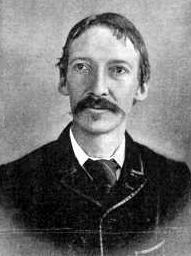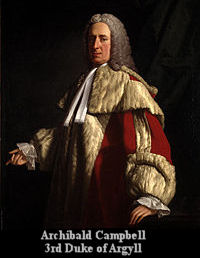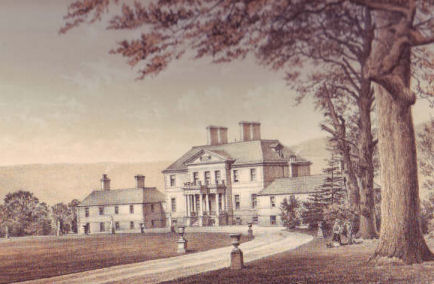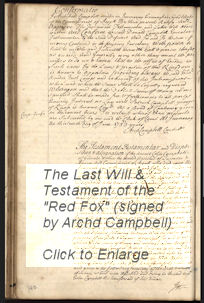Strathleven and the Appin Murder
 Largely because Robert Louis Stevenson (pictured) based his novel “Kidnapped” on it, the incident known as the Appin Murder is one of the most famous in Scottish history. In the aftermath of the ’45 Rebellion, lands which had belonged to Jacobite clans were taken over by the government and parcelled-out to supporters of the victorious House of Hanover.
Largely because Robert Louis Stevenson (pictured) based his novel “Kidnapped” on it, the incident known as the Appin Murder is one of the most famous in Scottish history. In the aftermath of the ’45 Rebellion, lands which had belonged to Jacobite clans were taken over by the government and parcelled-out to supporters of the victorious House of Hanover.
One of these was Colin Roy Campbell of Glenure. Colin Roy (who came to be known as the “Red Fox”) had served in the Earl of Loudoun’s regiment during the Rebellion. He was subsequently made factor over certain lands of Appin, which had belonged for centuries to the Stewarts.
Glenure’s mother had been a Cameron of Locheil. These Camerons having been staunch Jacobites, Colin Roy was suspected by some of having divided loyalties. It appears that he was on reasonably good terms with some of the Appin Stewarts, but he had to be careful not to seem to favour them. Accordingly, when ordered to evict certain Stewart families he had little choice but to enforce the instruction. Tolerated, respected, or even liked by some of the Appin Jacobites, there were others who detested him and all he stood for. Glenure knew that he was a marked man and that his life was in danger.
The evictions in question were due to take place in May of 1752. They involved clans-folk of James Stewart (known as James of the Glen). When James had heard of the proposed evictions he was furious with Glenure, and tried to prevent them by legal means. Around this time Alan Breck Stewart appeared in Appin. Alan was a foster-son of James. He had enlisted with the British army prior to the Rebellion, then at the Battle of Prestonpans changed sides to the Jacobites. He fought with the Appin regiment at the Battle of Culloden. After the defeat of Jacobite hopes Alan fled to France where he joined the French regiment of Ogilvy. From time to time he would be sent back to Appin to collect money for Stewart of Ardsheil, who had commanded the Appin men in the uprising.
Alan Breck wandered around his home country, drinking and socialising with friends and family, and allegedly making unwise threats as to how he would deal with the Red Fox if the chance came his way. On the 14th of May, as Colin Roy, with three companions, filed through the wood of Lettermore on their way to the place of the evictions, he was ambushed and fatally shot in the back by an unknown marksman.
A man with a dun-coloured coat and breeches was seen fleeing uphill from the scene of the crime. He was never captured or identified. The name of Glenure’s murderer remains a mystery to this day (although every so often it is allegedly revealed or deduced).
The killing was interpreted as a political assassination and it created shockwaves accordingly. This was but six years since the rebellion which had terrified the Hanoverian government, and in the aftermath of which the British authorities had resorted to perpetrating atrocities upon the people of the Highlands. Unnerved again, the establishment was determined to make a clear example to nip any further insurrection effectively in the bud. Prime suspect, not unreasonably, was Alan Breck Stewart, but he made good his escape to France and some other scapegoat had to be found.
 The famous historical incident became infamous. James of the Glen was arrested and imprisoned at Fort William. He was denied important legal rights. His trial was conducted in such a way that there would be no doubt as to its outcome. Witnesses were bullied and bribed. The jury was packed with Hanoverian Campbells. Presiding was the Lord Justice General, Archibald Campbell, Duke of Argyll.
The famous historical incident became infamous. James of the Glen was arrested and imprisoned at Fort William. He was denied important legal rights. His trial was conducted in such a way that there would be no doubt as to its outcome. Witnesses were bullied and bribed. The jury was packed with Hanoverian Campbells. Presiding was the Lord Justice General, Archibald Campbell, Duke of Argyll.
As was inevitable, James of the Glen was found guilty (not of having committed the murder, but of being a member of the conspiracy to commit it). He was hanged at Ballachulish on 8th November 1752.
In the two and a half centuries which have passed since that day the great majority of those who have investigated the circumstances have come to the conclusion that an innocent man was cynically hanged for political reasons.
On the 13th of November 2008 Glasgow solicitor John MacAulay, acting for a Mr.Campbell, lodged a formal submission with the Scottish Criminal Cases Review Commission to have the verdict overturned. A month later the Commission rejected the appeal.

Strathleven House
An important Vale of Leven connection with the Appin Murder has come to light. In 1732 the estate of Strathleven (then known as Levenside) was purchased by Archibald Campbell of Stonefield. He was an advocate and Sheriff-Depute of Argyll. Four days after the murder of Colin Roy Campbell, Stonefield travelled northward to Appin to gather evidence in the case.
Glenure’s nephew, Mungo, wrote a letter from Fort William on the 23rd of May 1752 (that is just nine days after the murder). The relevant passage from his letter reads –
 “Sheriff Campbell (Stonefield) Airds Carwhin Barcaldine and a good many others are now in the heart of Appin with a party of the King’s forces examining on oath the country people as to their knowledge of this matter but can make nothing of them and the odium seems generally to be put on Allan Breck Stewart…”
“Sheriff Campbell (Stonefield) Airds Carwhin Barcaldine and a good many others are now in the heart of Appin with a party of the King’s forces examining on oath the country people as to their knowledge of this matter but can make nothing of them and the odium seems generally to be put on Allan Breck Stewart…”
The Duke of Argyll was well aware that throughout the land there would be many who would look askance at the number of Campbells who sat on the jury. In a letter dated 25th July 1752 Archibald Campbell (now called “of Levenside”) pointed out that care had been taken to exclude the Barcaldine kin of Colin Roy Campbell.
Stonefield’s son, John Campbell of Levenside, was one of the five members of the counsel for the prosecution. On the 10th of October he wrote that –
“The Jacks (Jacobites) have espoused James Stuart’s side of the question very keenly, and cry out loudly against the jury, witnesses, etc., but luckily for the country the proof came out very strong.”
In the judgement on James of the Glen, which was read out by clerk, the following was stated…
“The said James Stewart to be carried back to the prison of Inveraray… and to then be transported to Fort William… to then be transported over the Ferry of Balllachulish and delivered over to the sheriff-depute of Argyllshire… to be hanged by the neck upon the said gibbet… until he be dead.” (author’s italics)
In the Scottish Historical Review, Volume 18 (1920-21), a full copy can be found of the –
Account of Disbursements of Archibald Campbell Sheriff Substitute of Argyleshire upon the Execution of James Stewart who was hung in chains at Ballichilish the 18th November 1752 for the Murder of Mr.Campbell of Glenure.
Grisly details are given of Levenfield’s expenses, such as –
To the Wrights for making the Gibbet and coming from Fortwilliam to Ballichilish to put it up…
To the Sheriff’s Expenses in going to Glasgow to engage an Executioner from thence not being sure of one from Inverness and not chusing to trust to one Executioner for fear of accidents.
To the Smith at Inverary for making the Chains and going from thence to put them on…
Archibald Campbell’s total costs amounted to £108. 17. 10
(This document came from the Treasury Board Papers: Bundle 355, No. 184)
It would appear that there is a very real sense in which it can be said that James of the Glen was hanged by the man from Levenside.
William Scobie
(Added February 2009)


